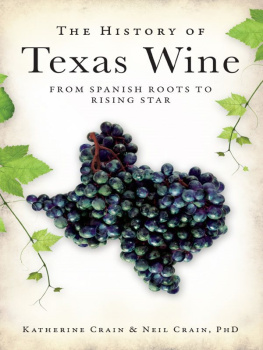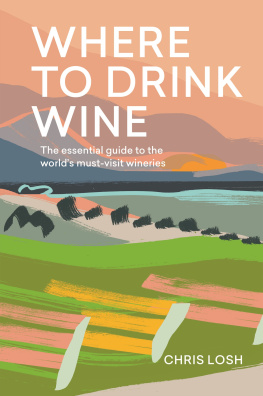I d like to thank the many members of the Virginia wine industry for their time and generosity, especially Lucie Morton for reviewing the viticulture chapter and Annette Boyd for her assistance arranging interviews with state officials on short notice and giving permission to reproduce the Wine Marketing Offices maps in this book.
Authors Note
T here are roughly two hundred wineries in Virginia, and unfortunately it was not possible to include them all in this book. In an effort to create a coherent narrative, the wineries and regions are presented as a travelogue, which necessarily limits the wineries covered. There are certainly other, equally valid routes to be explored. The inclusion or omission of a particular winery, or the length of any individual winery entry, is not meant to be a reflection on a winerys merits or importance. I encourage readers to visit wineries not in the book as well as those I have written about here, and to consult additional resources such as the wine bloggers cited, the official Virginia wine industry website (virginiawine.org), and winery websites for more information.

Orange County
R eturning from Pearmund Cellars to Rt. 29, turn right and continue south, following the signs for Rt. 29 south and the Rt. 17 bypass around Warrenton. Once you pass Rt. 17 at Opal, you leave the congestion of greater northern Virginia behind as you slip into the tranquil countryside. Soon after you cross the Rappahannock River into Culpeper County you pass the historic marker for the Civil War battle of Brandy Station in 1863, the largest cavalry battle ever fought in the Western Hemisphere.
The battle was fought at the start of General Lees Gettysburg campaign and was inconclusive on the field. However, historians note that from this point in the war, the dominance of the Confederate cavalry under J. E. B. Stuart ended, and cavalry units on both sides became more evenly matched.
Once you reach Culpeper, you could simply continue south on Rt. 29. If you did, youd reach Prince Michel Vineyards and Winery, in Leon. The best wines are the Vineyard Designate series, some of which have won impressive awards. The winery has two labels that help support preservation causes: Journey Through Hallowed Ground, and Patrons for Bellaire Parks.
To take a more scenic route, however, follow signs for Rt. 15 south when Rt. 29 passes Culpeper, onto the James Madison Highway toward Orange. Almost immediately, youll feel enveloped in the bosom of a timeless Virginia farmland, and when you reach the charming town of Orange youll feel youve reached a slower, kinder, gentler Virginia than the one you left behind with the traffic, farther north. Taking this route, youll miss wineries to the east, which you can learn more about by looking up the Heart of Virginia Wine Trail on the virginiawine.org website.
In Orange, turn right on Rt. 20. You are now on the Constitution Route, named for three important framers of the Constitution who lived near it: James Madison in Montpelier, Thomas Jefferson at Monticello, and James Monroe at Ash LawnHighland. Youll see signs for Montpelier, most of whose original construction and furnishings were recently restored. To visit, turn left across the railroad tracks.
Rt. 20 will T-intersect Rt. 33; turn left where they join for a short distance, then turn right on Rt. 20 again, and take the next leftRt. 678 (Governor Barbour St.)and continue straight. Youll see the Barboursville Vineyards on the right. Continue to the next intersection, where you turn right on Rt. 777 (Vineyard Rd.), then take the next right on Mansion Rd. onto the property. Turn left at the end of the first block of vines on the left and drive up to the winery.
You are now in the Central Piedmont and within the Monticello AVA. Bounded on the east by Southwestern Mountain and on the west by the crest of the Blue Ridge Mountains, it is at this point the most well-known Virginia AVA. The terrain is very hilly, giving good air and water drainage, and the region is cooler than the lower Piedmont to the east.
Barboursville Vineyards is one of the oldest wineries in the state and the oldest still operating in central Virginia and the Monticello AVA. It is also an iconic winery, with Tuscan-style arches along two right-angle wings, a distinctive cupola, and sweeping views of its vineyards and the Blue Ridge Mountains in the distance and Southwestern Mountain just behind the winery.
The vineyard and winery are owned by Gianni and Silvana Zonin, whose family business is Italys largest private wine producer. Original general manager and viticulturist Gabriele Rausse recalls that he and Gianni liked the challenge of attempting vinifera viticulture in a region where everybody said it couldnt be done. The wine being produced in Virginia at the time was, says Rausse, interesting, but I would not call it wine. Virginia Tech was not recommending planting vinifera, but rather the French hybrids. State Department of Agriculture officials offered them cigars and told them, This is the future of Virginia viticulture.
Thanks to their pioneering spirit, and the financial clout the Zonins brought to the investment in vinifera vineyards and modern winemaking equipment, the Virginia wine industry was given a shot in the arm. Barboursville showed that commercial vinifera viticulture was possible in Virginia, and others learned much from their example.
Some thirty-five years later, now under general manager and winemaker Luca Paschina (also a native of Italy), Barboursville is still in the forefront of defining and refining Virginia wine quality and style. Barboursville was one of the first wineries to introduce close (one-meter in-row) vine spacing, which has become the reigning paradigm in Virginia. In keeping with Italian custom, it has established a premier restaurant at the wineryPalladiowhich showcases the food-friendly style of the wines to great advantage. There is also an inn on the property for those who want to enjoy themselves and not worry about driving elsewhere.
Barboursville Vineyards is best known for its flagship proprietary red Bordeaux blend, Octagon (named for the trademark design Jefferson used at both the adjacent Barbour mansion and at Monticello). Octagon is a Right Bankstyle blend with around 60 percent merlot, plus varying amounts of cabernet franc and just a token amount of cabernet sauvignon.
While Octagon receives international acclaim, Italians are also known for pinot grigio, and Barboursvilles has been a consistent benchmark. Paschina harvests in August to retain the bright, fresh acidity that falls rapidly in that grape as it ripens; this pinot grigio is not just crisp and refreshing, but elegant. Another example of Barboursvilles continuing innovation is their use of several clones of sauvignon blanc that combine the best of Loire and Marlborough styles; the clones they used before would rot too easily and had nothing like the classic aroma and flavor of the replacements. Another innovation is a few acres of newly planted petite sirah. A consultant for the Zonin Wine House in France suggested trying it.
They cultivate the Piemontese grapes barbera and nebbiolo, with impressive results, and Paschina introduced a vin santostyle dessert wine. Select white grapes (muscat ottonel in this case) are carefully picked and dried on straw mats in special humidity-controlled rooms to avoid the risk of rot. The result, called Malvaxia, is a delicious, aromatic, but balanced and concentrated sweet white wine, with far less sharp pungency than is often found in Italian vin santo. Since its not too sweet, it can be matched with dark chocolate or rich cheese as well as desserts. The shed where the grapes for Malvaxia are dried is adjacent to the parking lot and is prominently labeled, so it can also function as consumer education and promotion.
Next page










